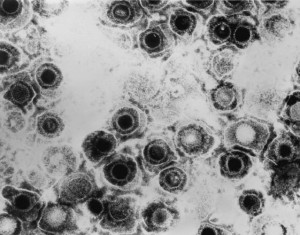
By Alex Binks.
Alex is an MRC-funded Ph.D. student at the University of Glasgow, working with Professor Iain McNeish at the Institute for Cancer Sciences and the Beatson Institute. Alex’s essay, about his research on oncolytic herpesviruses, was runner-up in the MRC Max Perutz Science Writing Competition 2015 and is published below in full with permission from Alex and the MRC. You can read all of the short-listed entries via the MRC website (PDF). Of interest, we have previously written about herpesviruses.
As far back as the early 1900s, scientists have been hotly debating the age-old question of “who would win in a fight?” in regards to certain diseases. Over the years, these discussions gradually moved out of the pub and into the lab after numerous observations that certain cancer patients saw spontaneous remission following a naturally acquired viral infection. By the 1950’s, scientists were becoming bold enough to begin injecting cancer patients themselves with live viruses, and were doing so with remarkable success. In the modern genetic age, oncolytic (“cancer-killing”) viruses have become more targeted, more effective and more innovative than ever, and are close to becoming a real treatment option for many cancers.
Cancer forms when certain cells within our bodies gain mutations in their DNA blueprints that allow them to grow and divide uncontrollably. These cells can often break free from their surroundings and take a joy ride throughout the body, getting stuck in important organs, stopping them from working properly.
Viruses are lone wanderers, all they want to do is reproduce and create more copies of themselves, but they lack the ability to do this on their own. Therefore in order to continue existing, viruses have to sneak into cells and hijack their copying machinery, creating their own production line of new viruses which can go on to infect new cells. A virus doesn’t care too much for the fate of the cell it infects; a virus’s only concern is keeping the cell functioning long enough to get enough new viruses off the production line, and as a result the cell ends up knackering its resources and often dies.
Oncolytic viruses can be made by taking a fully functional human virus such as herpes simplex virus, the causative agent of cold sores, and ripping out the genes required to cause disease. This leads to an “attenuated” form of the virus that is only able to infect cancer cells.

Let’s imagine the cell is a factory, and our virus is a secret agent trying to sneak in and switch out the factory blueprints for its own. A virus must do this without alerting the security within the cell to its presence, otherwise they can simply shut down the production line and stop the virus in its tracks. A normal unaltered virus can do this with no problem; years of evolution have given this virus all the secret agent training it needs to slip by security undetected. An oncolytic virus however, is more like an agent that’s had one too many martinis before beginning its mission. The once graceful virus now staggers its way through the factory, knocking over tables and making its presence known to the cell.
So these viruses are too sloppy to harm our healthy working cells, but cancer cells are sloppy too. In their quest to divide and conquer, cancer cells become highly deregulated; these are cell factories that have been turned into an all-night rave. While the cellular machinery may still be running, amid the chaos there’s no maintenance or quality control. Meanwhile, the cellular security is either non-existent or non-functional. This means that despite the sloppiness, our oncolytic virus is still able to make it inside, start production, and watch the cancer cell fall to pieces without detection.
For my research, I’m interested in finding out how infection with oncolytic herpes virus leads to the death of a cell. The process of dying for a cell is less straight-forward than you might think, and in general a cell can die in one of two ways: apoptosis or necrosis. In apoptosis, the cell shrinks, breaks itself down and disappears without a fuss. You could compare this to our cancer cell rave simply shutting down, with everyone leaving in an orderly manner. However necrosis is more akin to the factory entering into self-destruct mode, the cell swells and bursts, going out in style with debris being flung across the entire neighbourhood.
In fact the difference between these types of cell death is incredibly important in how our bodies respond to cancer. Our immune cells actually play a big role in the body’s fight against cancer; these are like circulating police, trying to shut down these cancerous cell raves where they can find them. As you can imagine, cells that die by messy, explosive necrosis attract a lot more attention from immune cells, which makes it easier for them to find other cancerous cells in the area and actually contribute to the cancer cell killing.
By trying to better understand how herpes virus is causing cancer cells to die, my hope is to find new ways to tinker with these viruses so that they induce more necrotic cell death, and develop better cancer treatments that work with our immune systems to help prime them in their fight against cancer.

